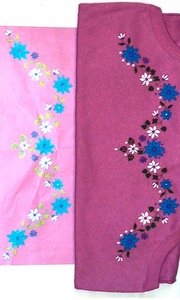L.A. Apparel Co. in Legal Battle With J.C. Penney
Montebello, Calif.–based girls’ apparel maker Guild Inc. filed a lawsuit on April 29 in Los Angeles Federal Court against J.C. Penney Corp. for copyright infringement and unfair business practices. The company is seeking more than $3.5 million in damages and a temporary restraining order for the retailer’s alleged use of a floral screen design that appeared on girls’ tank tops.
J.C. Penney did not respond to requests for comment on the lawsuit.
According to the suit, J.C. Penney has placed orders for girls’ apparel with Guild since 1954. Guild said it presented the floral design to J.C. Penney in July 2000 and was to incorporate the design into the retailer’s color palette. But in September 2000, J.C. Penney decided against purchasing the design and refused to return samples to Guild, according to court documents. In May 2001, Guild discovered J.C. Penney was promoting and selling tank tops bearing what it said was a design identical to its own screenprinted floral design.
“I’m very hurt and shocked that they would treat our company like this,” said Guild owner Janine Gualderon, who purchased the $40 million privately owned company 20 years ago. “J.C. Penney acted with impunity when they began selling tank tops featuring our floral design without our consent.”
Guild’s floral screen print was registered as a trademark a few years ago, said Gualderon. In addition to seeking damages, Guild is asking the court to impound and destroy any and all items that allegedly infringed upon the company’s copyright.
The Laguna Beach, Calif.–based firm Levin Intellectual Property Group is representing Guild. Judge Margaret M. Morrow will preside over the case.
The allegations in the complaint are serious but not uncommon, according to Crystal Zarpas, a partner at Mann and Zarpas in Woodland Hills, Calif.
Zarpas said the crucial issue in this case for the court to decide is whether or not the samples/ designs that Guild alleges were misappropriated by J.C. Penney are the type of original and creative work that can be copyrighted.
“If a particular design is not of a type which can be copyrighted, the creator of that design can still protect his work by obtaining a design patent,” Zarpas explained. “However, this type of patent can only be protected if the designer formally obtains a design patent.”
Zarpas said whenever possible, companies should take steps to protect original, creative designs through the copyright process before using them for any purpose.
“One should not assume that a design not formally copyrighted can be used by anyone without limitation,” she added. —Claudia Figueroa






















